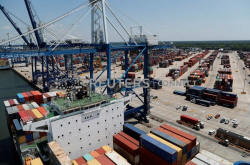U.S. economy growing moderately in fourth quarter;
likely missed Trump's 3% goal in 2019
 Send a link to a friend
Send a link to a friend
 [January 30, 2020] By
Lucia Mutikani [January 30, 2020] By
Lucia Mutikani
WASHINGTON (Reuters) - The U.S. economy
likely maintained a moderate pace of growth in the fourth quarter, and
probably again fell short of attaining the Trump administration's
coveted but elusive 3% annual growth target because of slumping business
investment amid damaging trade tensions.
The Commerce Department's snapshot of gross domestic product on Thursday
will likely show the Federal Reserve's three interest rate cuts in 2019
helped to keep the longest expansion in history, now in its 11th year,
on track and avert a downturn.
Growth is, however, slowing as the stimulus fades from the White House
and Republicans' huge tax reductions in 2018, a package President Donald
Trump had predicted would lift growth persistently above 3%. So far it
has fallen short of that goal.
The report comes on the heels of the U.S. Federal Reserve deciding to
keep rates unchanged. Fed Chairman Jerome Powell told reporters on
Wednesday the U.S. central bank expected "moderate economic growth to
continue" but also nodded to some risks, including the recent
coronavirus outbreak in China.
The Trump administration's 18-month-long trade war with China last year
fueled fears of a recession. Though the economic outlook has improved
with this month's signing of a Phase 1 deal with Beijing, economists do
not see a boost to the economy as U.S. tariffs remained in effect on
$360 billion of Chinese imports, about two-thirds of the total.

"The economy has clearly slowed, but we are not barreling toward a
recession," said Ryan Sweet, senior economist at Moody's Analytics in
West Chester, Pennsylvania. "The economy is coming off its sugar high in
2019 so is not surprising that we are settling back into the growth
rates that we saw prior to the fiscal stimulus."
Gross domestic product probably increased at a 2.1% annualized rate in
the fourth quarter as lower borrowing costs encouraged purchases of
motor vehicles, houses and other big ticket items, according to a
Reuters survey of economists. A smaller import bill and more government
spending are also seen keeping GDP growth at the same pace logged in the
third quarter.
The forecast was, however, made before Wednesday's advance reports
showing a sharp widening in the goods trade deficit in December as well
as a drop in wholesale inventories. Retail inventories were unchanged
last month. The data prompted some economists to cut their
fourth-quarter GDP growth estimates by as much as five-tenths of a
percentage point to as low as a 1.4% rate.
Growth estimates for 2019 are converging around 2.5%, which would be
slower than the 2.9% notched in 2018. Economists estimate the speed at
which the economy can grow over a long period without igniting inflation
at around 1.8%.
The White House claimed that slashing the corporate tax rate to 21% from
35%, as well as shrinking the trade deficit would boost annual GDP
growth to 3.0% on an sustainable basis. Economists have long disagreed,
pointing to structural issues like low productivity and population
growth. Some also argued that there was historically not a very strong
relationship between corporate tax rates and business investment.
[to top of second column] |

The view from one of the
ship-to-shore cranes at Wando Welch Terminal operated by the South
Carolina Ports Authority in Mount Pleasant, South Carolina, U.S. May
10, 2018. REUTERS/Randall Hill

TOUGH TASK
"If you are trying to get to 3% in an economy in its 11th year of
recovery that's a tough task," said Sung Won Sohn, business economics
professor at Loyola Marymount University in Los Angeles. "There is a lot
of uncertainty. Even though we have this initial trade agreement, I
think there will be more trade wars after the (U.S. presidential)
election."
Fed Chair Powell also said the risks from trade tensions remained and
businesses were adopting a "wait and see attitude."
Business investment likely contracted further in the fourth quarter
after declining by the most in nearly four years in the July-September
period. Trade tensions have eroded business confidence and weighed on
capital expenditure.
With confidence among chief executive officers remaining low in the
fourth quarter after dropping to a 10-year low in the prior quarter, a
rebound is unlikely soon.
Business investment is also seen pressured by Boeing's suspension this
month of the production of its troubled 737 MAX jetliner, which was
grounded last March following two fatal crashes. Boeing on Wednesday
reported its first annual loss since 1997.
Though growth in consumer spending, which accounts for more than
two-thirds of U.S. economic activity, is expected to have moderated
after a brisk 3.2% rate in the third quarter, the pace was probably
enough to offset the drag from business investment.
Support is also expected from a sharp drop in imports in the fourth
quarter, in part because of U.S. tariffs on Chinese goods, which
compressed the trade deficit.
Economists believe the smaller trade deficit probably added as much as
1.9 percentage points to GDP growth in the fourth quarter. That estimate
could, however, be too high given the rebound in imports in December
reported in Wednesday's data.
But the overall decline in imports in the fourth quarter probably
resulted in businesses depleting inventories in warehouses. A 40-day
strike at General Motors also weighed on motor vehicle inventories.

Goldman Sachs estimates that overall business inventories increased at a
$2.0 billion rate in the fourth quarter, decelerating sharply from a
pace of $69.4 billion in the July-September period. That means inventory
investment chopped 1.4 percentage points from GDP growth in the fourth
quarter.
(Reporting by Lucia Mutikani; Editing by Dan Burns and Andrea Ricci)
[© 2020 Thomson Reuters. All rights
reserved.] Copyright 2020 Reuters. All rights reserved. This material may not be published,
broadcast, rewritten or redistributed.
Thompson Reuters is solely responsible for this content. |